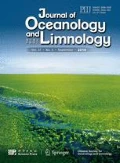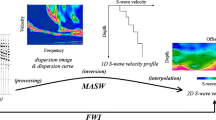Abstract
Shallow marine sand waves are formed on the seabed and are widely distributed within tidal environments. However, the use of multibeam echo sounding (MBES) is costly to obtain the bathymetric mapping of large complex sand waves. Therefore, we propose a new method that employs a combination of multiangle sun glint images and sparse MBES data to achieve comprehensive bathymetric mapping of large and complex sand waves. This method involves estimating sea surface roughness, automatically extracting sand-wave crests, conducting adaptive subregion partitioning, estimating the water depth at auxiliary points, and generating digital bathymetric models. The method was employed in a case study of sand waves on the Taiwan Bank. Bathymetric mapping was implemented for large complex sand waves over an area spanning approximately 350 km2 using multiangle sun glint images from the Advanced Spaceborne Thermal Emission and Reflection Radiometer and MBES data. The results show that mapped and measured water depths were well-matched; the root-mean-square error of water depths was 1.77 m, and the relative error was 5.03%. These findings show that bathymetric mapping of large complex sand waves can be effectively conducted using the new method, and as such, the workload of MBES is reduced and efficiency is improved.
Similar content being viewed by others
Data Availability Statement
The datasets generated and / or analyzed during the current study are not publicly available due to state policy restrictions, but are available from the corresponding author on reasonable request.
Abbreviations
- MBES:
-
multibeam echo sounding
- ASTER:
-
advanced spaceborne thermal emission and reflection radiometer
- SSR:
-
sea surface roughness
- SAR:
-
synthetic aperture radar
- DBMs:
-
digital bathymetric models
- FFT:
-
fast Fourier transform
- IDSW:
-
distance square weighting method
- UTC:
-
coordinated universal time
- NVI:
-
nadir-looking-view image
- VNIR:
-
visible and near-infrared
- BVI:
-
backward-looking-view image
- NASA:
-
National Aeronautics and Space Administration’s
- SWIR:
-
shortwave infrared
- TIR:
-
thermal infrared
- RMSE:
-
root-mean-square error
- BAS:
-
bathymetry assessment system
References
Allen J R L. 1982. Simple models for the shape and symmetry of tidal sand waves: (1) statically stable equilibrium forms. Marine Geology, 48(1–2): 31–49, https://doi.org/10.1016/0025-3227(82)90128-1.
Alpers W, Hennings I. 1984. A theory of the imaging mechanism of underwater bottom topography by real and synthetic aperture radar. Journal of Geophysical Research: Oceans, 89(C6): 10529–10546, https://doi.org/10.1029/JC089iC06p10529.
Bao J J, Cai F, Ren J Y, Zheng Y L, Wu C Q, Lu H Q, Xu Y 2014. Morphological characteristics of sand waves in the Middle Taiwan Shoal based on multi-beam data analysis. Acta Geologica Sinica-English Edition, 88(5): 1499–1512, https://doi.org/10.1111/1755-6724.12314.
Boggs S Jr. 1974. Sand-wave fields in Taiwan Strait. Geology, 2(5): 251–253, https://doi.org/10.1130/0091-7613(1974)2<251:SFITS>2.0.CO;2.
Cai A Z, Zhu X N, Li Y M, Cai Y E. 1992. Sedimentary environment in Taiwan Shoal. Chinese Journal of Oceanology and Limnology, 10(4): 331–339, https://doi.org/10.1007/BF02843834.
Calder B R, Mayer L A. 2003. Automatic processing of highrate, high-density multibeam echosounder data. Geochemistry, Geophysics, Geosystems, 4(6): 1048, https://doi.org/10.1029/2002GC000486.
Calkoen C J, Hesselmans G H F M, Wensink G J, Vogelzang J. 2001. The bathymetry assessment system: efficient depth mapping in shallow seas using radar images. International Journal of Remote Sensing, 22(15): 2973–2998, https://doi.org/10.1080/01431160116928.
Cox C, Munk W. 1954. Measurement of the roughness of the sea surface from photographs of the sun’s glitter. Journal of the Optical Society of America, 44(11): 838–850, https://doi.org/10.1364/JOSA.44.000838.
De Loor G P, Brunsveld van Hulten H W. 1978. Microwave measurements over the North Sea. Boundary-Layer Meteorology, 13(1): 119–131, https://doi.org/10.1007/BF00913866.
Du X Q, Li Y, Gao S. 2008. Characteristics of the large-scale sandwaves, tidal flow structure and Bedload transport over the Taiwan Bank in Southern China. Acta Oceanologica Sinica, 30(5): 124–136, https://doi.org/10.3321/j.issn:0253-4193.2008.05.017. (in Chinese with English abstract)
He X K, Chen N H, Zhang H G, Fu B, Wang X Z. 2014. Reconstruction of sand wave bathymetry using both satellite imagery and multi-beam bathymetric data: a case study of the Taiwan Banks. International Journal of Remote Sensing, 35(9): 3286–3299, https://doi.org/10.1080/01431161.2014.902551.
He X K, Chen N H, Zhang H G, Guan W B. 2015. The brightness reversal of submarine sand waves in “HJ-1A/B” CCD sun glitter images. Acta Oceanologica Sinica, 34(1): 94–99, https://doi.org/10.1007/s13131-015-0602-2.
Hennings I, Doerffer R, Alpers W. 1988. Comparison of submarine relief features on a radar satellite image and on a Skylab satellite photograph. International Journal of Remote Sensing, 9(1): 45–67, https://doi.org/10.1080/01431168808954836.
Hennings I, Matthews J, Metzner M. 1994. Sun glitter radiance and radar cross-section modulations of the sea bed. Journal of Geophysical Research: Oceans, 99(C8): 16303–16326, https://doi.org/10.1029/93JC02777.
Katoh K, Kume H, Kuroki K, Hasegawa J. 1998. The development of sand waves and the maintenance of navigation channels in the Bisanseto Sea. In: Proceedings of the 26th International Conference on Coastal Engineering. American Society of Civil Engineers, Copenhagen. p.3490–3502, https://doi.org/10.1061/9780784404119.265.
Li F. 2012. Annual variations of Secchi depth in the nearshore waters of the western Taiwan Strait during the summers of 1998–2010. Journal of Oceanography in Taiwan Strait, 31(3): 301–306.
Li Y, Hu J Y, Li J, Fu B, Ma L M. 2003. Optical image modulation above the submarine bottom topography: a case study on the Taiwan Banks, China. In: Proceedings of the SPIE 4892, Ocean Remote Sensing and Applications. SPIE, Hangzhou, https://doi.org/10.1117/12.466156.
Liu Z C, Zhou X H, Chen Y L, Hu G H. 2005. The development in the latest technique of shallow water multi-beam sounding system. Hydrographic Surveying and Charting, 25(6): 67–70, https://doi.org/10.3969/jissn.1671-3044.2005.06.020. (in Chinese with English abstract)
Lyzenga D R. 1977. Reflectance of a flat ocean in the limit of zero water depth. Applied Optics, 16(2): 282–283, https://doi.org/10.1364/AO.16.000282.
Lyzenga D R. 1978. Passive remote sensing techniques for mapping water depth and bottom features. Applied Optics, 17(3): 379–383, https://doi.org/10.1364/AO.17.000379.
Matthews J P, Yang X D, Shen J, Awaji T. 2008. Structured Sun glitter recorded in an ASTER along-track stereo image of Nam Co Lake (Tibet): an interpretation based on supercritical flow over a lake floor depression. Journal of Geophysical Research: Oceans, 113(C1): C01019, https://doi.org/10.1029/2007JC004204.
Matthews J. 2005. Stereo observation of lakes and coastal zones using ASTER imagery. Remote Sensing of Environment, 99(1–2): 16–30, https://doi.org/10.1016/j.rse.2005.04.029.
Morelissen R, Hulscher S J M H, Knaapen M A F, Németh A A, Bijker R. 2003. Mathematical modelling of sand wave migration and the interaction with pipelines. Coastal Engineering, 48(3): 197–209, https://doi.org/10.1016/S0378-3839(03)00028-0.
Passchier S, Kleinhans M G. 2005. Observations of sand waves, megaripples, and hummocks in the Dutch coastal area and their relation to currents and combined flow conditions. Journal of Geophysical Research: Earth Surface, 110(F4): F04S15, https://doi.org/10.1029/2004JF000215.
Shao H, Li Y, Li L. 2011. Sun glitter imaging of submarine sand waves on the Taiwan Banks: determination of the relaxation rate of short waves. Journal of Geophysical Research: Oceans, 116(C6): C06024, https://doi.org/10.1029/2010JC006798.
Shao H, Li Y, Li L. 2014. Priori knowledge based a bathymetry assessment method using the sun glitter imagery: a case study of sand waves on the Taiwan Banks. Acta Oceanologica Sinica, 33(1): 120–126, https://doi.org/10.1007/s13131-014-0375-z.
Whitehouse R, Beech N, Hulscher S J M H, Huntley D. 1998. Understanding the behaviour and engineering significance of offshore and coastal sandbanks. In: Proceedings of the 33rd MAFF Conference of River and Coastal Engineers. Keele University, London. p.2.3.1–2.3.14.
Xu J P, Wong F L, Kvitek R, Smith D P, Paull C K. 2008. Sandwave migration in Monterey Submarine Canyon, Central California. Marine Geology, 248(3–4): 193–212, https://doi.org/10.1016/j.margeo.2007.11.005.
Yang K, Zhang H G, Fu B, Zheng G, Guan W B, Shi A Q, Li D L. 2015. Observation of submarine sand waves using ASTER stereo sun glitter imagery. International Journal of Remote Sensing, 36(22): 5576–5592, https://doi.org/10.1080/01431161.2015.1101652.
Zhang H G, Lou X L, Shi A Q, He X K, Guan W B, Li D L. 2014. Observation of sand waves in the Taiwan Banks using HJ-1A/1B sun glitter imagery. Journal of Applied Remote Sensing, 8(1): 083570, https://doi.org/10.1117/1.JRS.8.083570.
Zhang H G, Yang K, Lou X L, Li D L, Shi A Q, Fu B. 2015. Bathymetric mapping of submarine sand waves using multiangle sun glitter imagery: a case of the Taiwan Banks with ASTER stereo imagery. Journal of Applied Remote Sensing, 9(1): 095988, https://doi.org/10.1117/1.JRS.9.095988.
Zhang H G, Yang K, Lou X L, Li Y, Zheng G, Wang J, Wang X Z, Ren L, Li D L, Shi A Q. 2018. Observation of sea surface roughness at a pixel scale using multi-angle sun glitter images acquired by the ASTER sensor. Remote Sensing of Environment, 208: 97–108, https://doi.org/10.1016/j.rse.2018.02.004.
Zhou J Q, Wu Z Y, Jin X L, Zhao D N, Cao Z Y, Guan W B. 2018. Observations and analysis of giant sand wave fields on the Taiwan Banks, northern South China Sea. Marine Geology, 406: 132–141, https://doi.org/10.1016/j.margeo.2018.09.015.
Acknowledgment
The authors wish to acknowledge the cooperative efforts between NASA and Japan’s Ministry of Economy Trade and Industry (METI) during development of the ASTER sensor. The bathymetry datasets used in this study were obtained from the Public Science and Technology Research Fund Project of Ocean (No. 201105001). The authors would like to thank Professor Yan LI from Xiamen University for his comments on this paper.
Author information
Authors and Affiliations
Corresponding authors
Additional information
Supported by the National Natural Science Foundation of China (Nos. 41876208, 41830540, 41576174)
Rights and permissions
About this article
Cite this article
Zhang, H., Wang, J., Li, D. et al. Reconstruction of large complex sand-wave bathymetry with adaptive partitioning combining satellite imagery and sparse multi-beam data. J. Ocean. Limnol. 40, 1924–1936 (2022). https://doi.org/10.1007/s00343-021-1216-5
Received:
Accepted:
Published:
Issue Date:
DOI: https://doi.org/10.1007/s00343-021-1216-5




